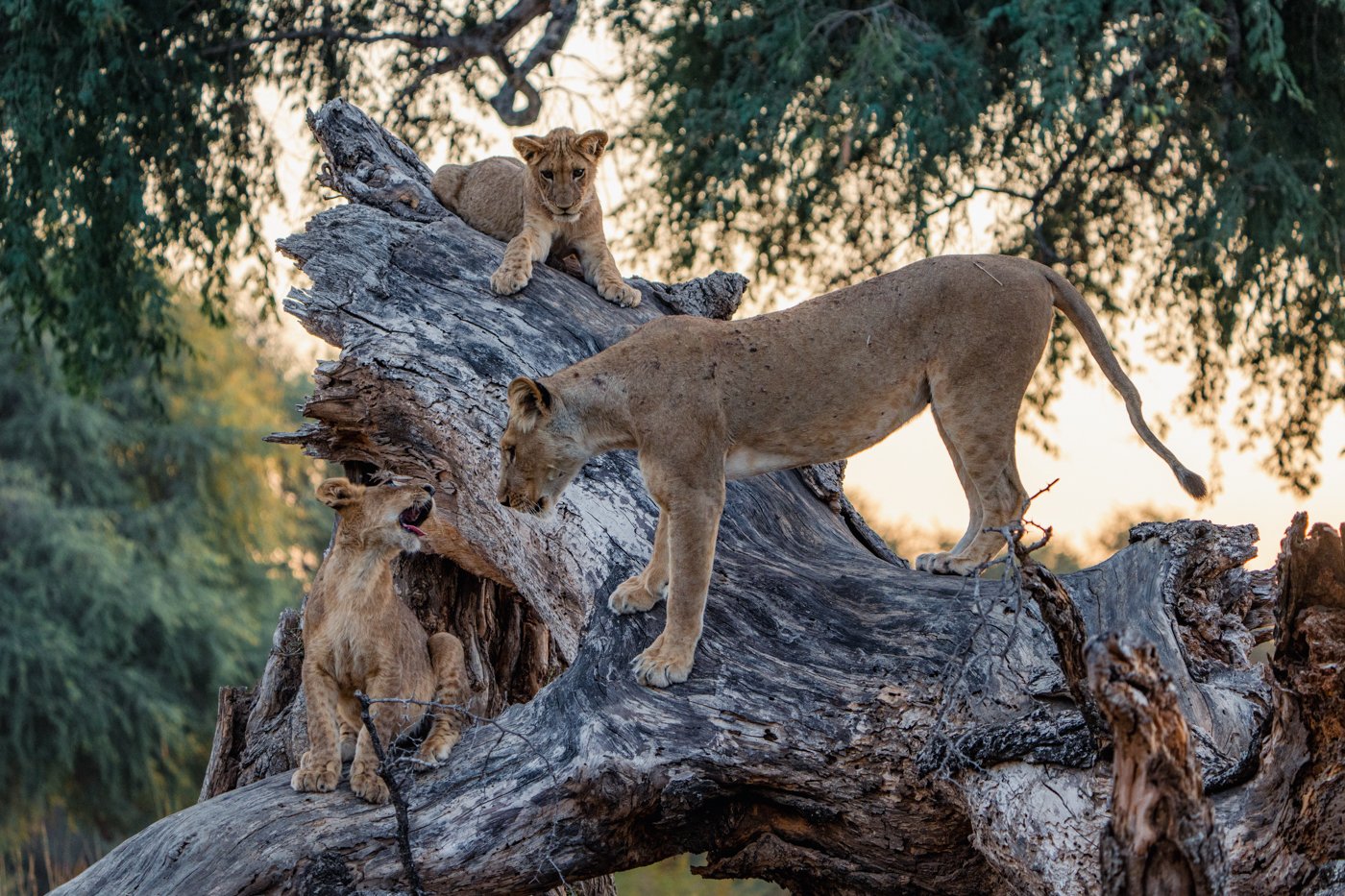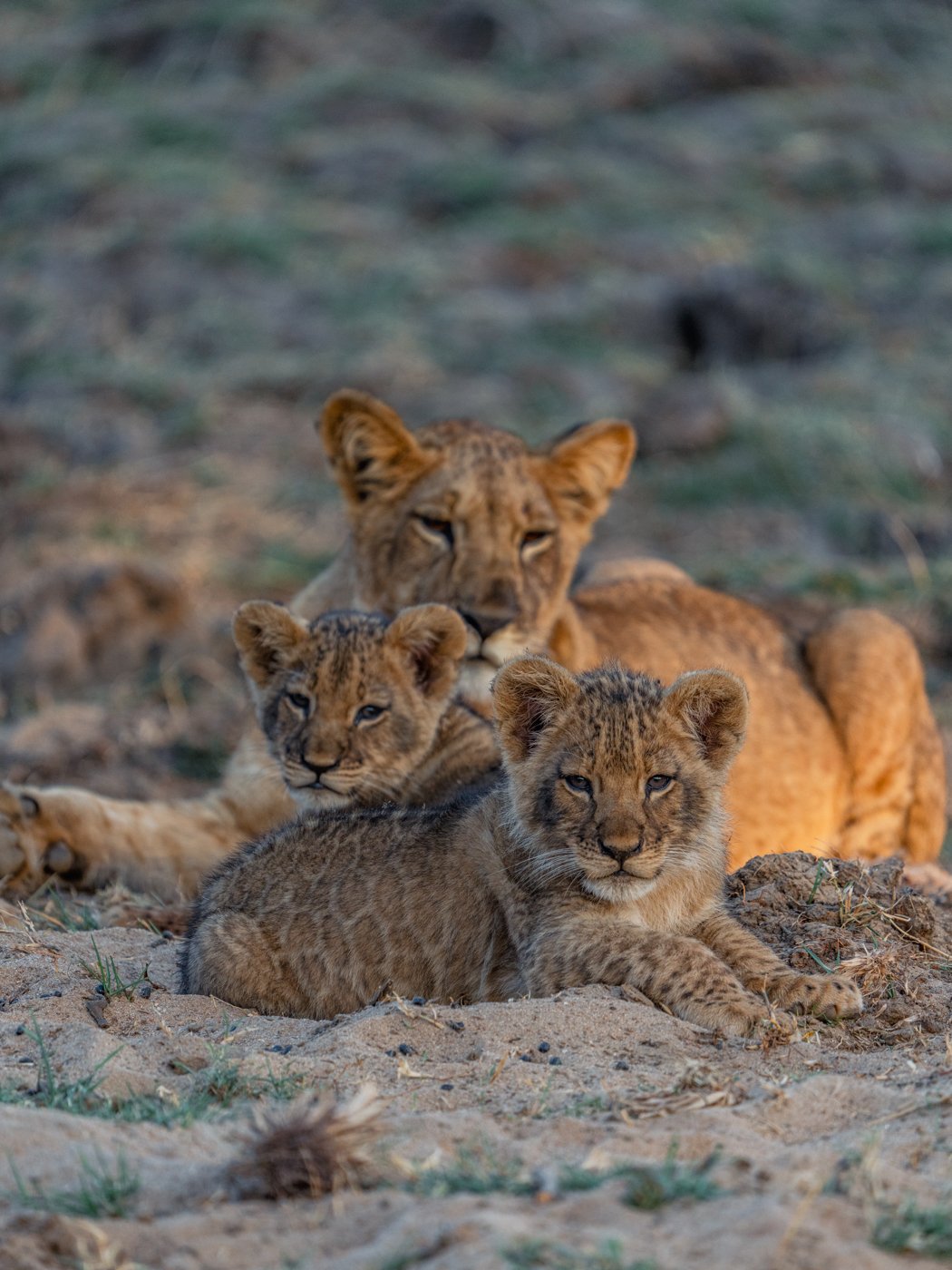The Challenges of Lion Cubs: Surviving the Wild to Adulthood
This season we have welcomed five new lion cubs to the pride, with the newest (and tiniest) members debuting just last month! Lion cubs, born into the wild landscapes of Africa, face a treacherous journey to adulthood. With a survival rate of less than 50% in some regions, the odds are often against these young predators. Their path is marked by numerous challenges, from predation and starvation to disease and the dangers posed by other lions. In the past 3 years we have sadly watched the resident pride lose over four cubs. Understanding the challenges these little ones face sheds light on the harsh realities of life in the wild for these iconic creatures.
Three new born cubs about three weeks old spotted at Anabezi a couple of weeks ago.
Vulnerable Beginnings
Lion cubs are born blind and weigh about 2 to 4 pounds. During the first few weeks of life, they are entirely dependent on their mother. The lioness carefully hides her cubs from predators such as hyenas, leopards, and even other lions. Unfortunately, despite her best efforts, only about 20% of cubs make it to their second birthday. This high mortality rate is due in part to predation but also to the natural hazards of the environment, and also why the cubs remain invisible for at least three weeks - often longer. When they are finally ready to greet the world, their mother must be on high alert at all times.
The Perils of Infanticide
One of the greatest threats to lion cubs comes from male lions within their own pride. Infanticide, where new dominant males kill the cubs sired by previous males, is a common but brutal strategy in the wild. This behavior ensures that the lionesses come back into estrus more quickly, allowing the new males to sire their offspring. Studies have shown that up to 25% of lion cubs may fall victim to infanticide .
Lionesses do their best to protect their cubs, sometimes hiding them or moving them to new locations. However, when a new male coalition takes over a pride, the lionesses have little choice but to accept this harsh reality. The survival of their cubs in such circumstances is a matter of chance and timing. Here in the Kulefu area of Lower Zambezi, this is exactly what happened. Last year’s cubs belonged to our previous resident males Blackie and Blondie, both elderly lions around 13 years old. When new younger males came in, they killed the cubs to ensure they could continue their own genetic line.
The pride's first set of cubs this season, captured at Anabezi in July.
Hunger and Disease: Constant Threats
The battle for survival extends beyond external threats. Starvation is a constant danger, particularly during periods when prey is scarce. Lion cubs are often the last to eat after a successful hunt, and in times of scarcity, they may not get enough food to sustain them. This is especially true during the dry season when prey becomes more difficult to find.
Disease is another significant threat. As cubs begin to wean and eat solid food, they are exposed to pathogens and parasites that can quickly decimate a litter. The lack of a developed immune system in young cubs makes them particularly vulnerable to diseases that adult lions can more easily resist.
Learning to Hunt: A Lifeline to Survival
Hunting skills are vital for the survival of lion cubs as they grow. The process of learning to hunt begins with play—stalking, pouncing, and wrestling with siblings. These activities are more than just games; they are essential for developing the skills needed to take down large prey as adults. However, mastering these skills takes time, and not all cubs succeed. Failure to learn how to hunt can lead to starvation, making this a crucial period in a young lion’s life .
Two of the newest lion cubs, still heavily covered in spots at about 3 weeks old.
The Role of the Pride
The social structure of a pride is essential to the survival of lion cubs. A stable pride, led by experienced lionesses, offers better protection and a higher chance of survival for the young. Lionesses within a pride often work together to raise the cubs, sharing the responsibilities of hunting and protecting them from threats. However, when pride dynamics are disrupted—such as when new males take over—the stability that the cubs rely on can be shattered, increasing their vulnerability.
The Statistics: A Sobering Reality
The statistics surrounding lion cub survival are sobering. In the Serengeti, for instance, research shows that approximately 50% of lion cubs die before reaching two years of age. This high mortality rate is due to a combination of factors, including predation, starvation, disease, and infanticide .
Despite these challenges, those cubs that survive to adulthood contribute to the strength and continuation of the pride. The journey from birth to adulthood is a testament to the resilience and adaptability of these majestic animals. The survival of lion cubs is a delicate balance of nature, where every day is a struggle, and only the strongest make it to maturity.
With the current pride dynamics in place - strong healthy males, two of the three adult lionesses raising cubs together and the first set of cubs born this year now beyond 6 months old - chances are high for this group’s survival.
By understanding the challenges that lion cubs face, conservation efforts can be better targeted to protect these vulnerable creatures. The story of lion cubs is one of survival against the odds—a powerful reminder of the harsh realities of life in the wild and the importance of preserving these magnificent animals for future generations.
The newest lion cubs suckling, captured at Anabezi in August.





